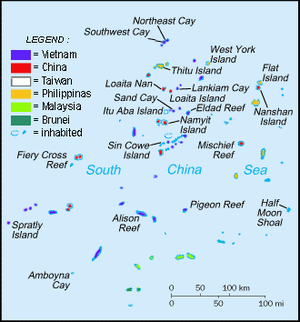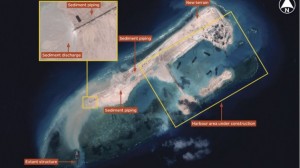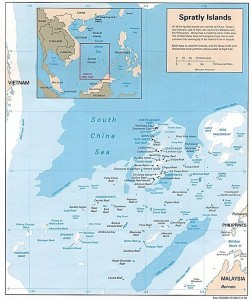Furor Over the Fiery Cross Reef
A report by IHS Jane’s Defence Weekly last week on the building of a suspected airstrip on Fiery Cross Reef has stirred up an international uproar over China’s intentions in the Spratly Islands chain in the South China Sea.
Lying southwest of the main Spratly island archipelago, Fiery Cross Reef, otherwise known as Yongshu Reef in Chinese, is a group of three reefs controlled by China as part of its Sansha Island chain. In 1988, the People’s Liberation Army Navy (PLAN) built a UNESCO Marine observation station there and has since stationed around 200 troops on the reef.  China has been at a disadvantage compared with other claimant countries in the Spratlys as it is the only one without an airfield on an occupied island. Taiwan possesses Itu Abu (Taiping) Island, the Philippines has Thitu (Pasaga) Island, Malaysia occupies Swallow Reef (an airstrip was built on reclaimed land) and Vietnam took Southwest Cay.
China has been at a disadvantage compared with other claimant countries in the Spratlys as it is the only one without an airfield on an occupied island. Taiwan possesses Itu Abu (Taiping) Island, the Philippines has Thitu (Pasaga) Island, Malaysia occupies Swallow Reef (an airstrip was built on reclaimed land) and Vietnam took Southwest Cay.
Airbus Defence and Space satellite images of the island taken on August 8th and three months later on November 14th indicated Chinese dredging had resulted in a new island more than 3,000 meters long and 200-300 meters wide, big enough for a runway and an apron. Along with the runway was a harbor toward the east of the island that looked large enough to take tankers and major war vessels.  According to IHS Jane’s, this land reclamation project is the fourth undertaken by the Chinese in the Spratlys over the past year to 18 months following similar efforts on Johnson South Reef, Cuateron Reef, and Gaven Reefs, none of which were big enough to accommodate an airstrip. The Fiery Cross Reef construction brings China parity with other claimants but also likely considerable concern among them, analyzed Jane’s.
According to IHS Jane’s, this land reclamation project is the fourth undertaken by the Chinese in the Spratlys over the past year to 18 months following similar efforts on Johnson South Reef, Cuateron Reef, and Gaven Reefs, none of which were big enough to accommodate an airstrip. The Fiery Cross Reef construction brings China parity with other claimants but also likely considerable concern among them, analyzed Jane’s.
The journal was quite alarmist in suggesting, “given its massive military advantage over other claimants in terms of quantity and quality of materiel, this facility appears purpose-built to coerce other claimants into relinquishing their claims and possessions or at least provide China with a much stronger negotiating position if talks over the dispute were ever held.”
This latest installment of the ‘China threat’ story got further traction when Jin Zhirui, a colonel with the Chinese Air Force, speaking to reporters at the sidelines of the Xiangshan Forum, China’s answer to other regional defence dialogues, declined to confirm the activities on the reef but nevertheless remarked, “we need to go out, to make our contribution to regional and global peace. We need support like this, including radar and intelligence.”
Almost immediately, the Americans obligatorily called on China to halt the project: “We urge China to stop its land reclamation program, and engage in diplomatic initiatives to encourage all sides to refrain themselves in these sorts of activities, US military Spokesman Lieutenant Colonel Jeffrey Pool urged (quoted by the South China Morning Post). To which Chinese Foreign Ministry spokeswoman Hua Chunying retorted, “I think anyone in the outside world has no right to make irresponsible remarks on China-related activities.”
Air force Colonel Jin pointed to other claimant countries making significant military advances in the area ahead of China. “Although there are 50 islands and reefs in the Nasha Islands, those belonging to China are the fewest in number and China was the last to make advances there”, he said. Interviewed by the Global Times, PLA Major General Luo Yuan added, “The US is obviously biased considering that the Philippines, Malaysia, Vietnam have already set up military facilities….China is likely to withstand the international pressure and continue the construction since it is completely legitimate and justifiable”.
In addition to its occupation of and construction of facilities on Thitu Island, in 1999, the Philippines deliberately ran aground a tattered navy ship, the Number 57 – BRP Sierra Madre, near the Second Thomas Shoal, establishing it as an ‘outpost’ on which troops have been stationed ever since. And numerous flare-ups have occurred between Chinese navy and other ships and their Vietnamese counterparts.
Interestingly, following the disclosure, during a recent round of constitutional arguments on the Philippines’ Enhanced Defence Cooperation Agreement (EDCA) with the US, Associate Justice Antonio Carpio, an ardent anti-China hawk, grilled acting Solicitor General Florin Hilbay to admit that even if EDCA were considered constitutional, there is no guarantee that the country’s protector would come to its aid in case of an external attack. The Aquino government has been trying hard to convince political elites and the public that the country would be protected should push comes to fisticuffs in a showdown with China over the Spratlys.


0 Comments
Trackbacks/Pingbacks